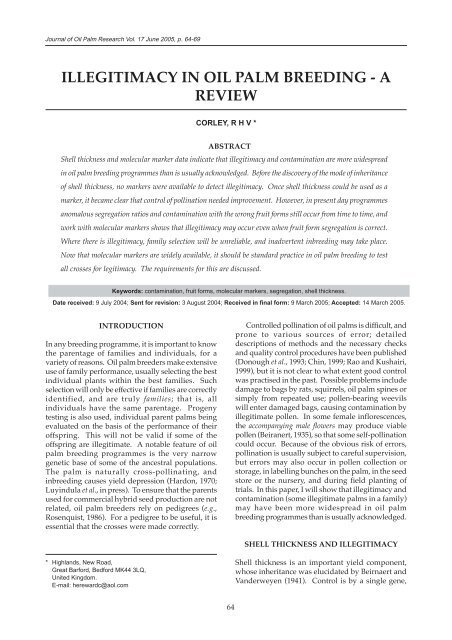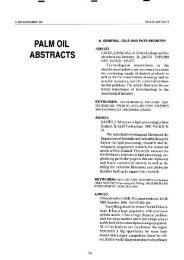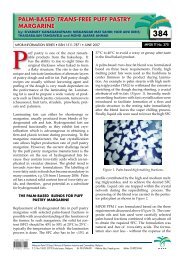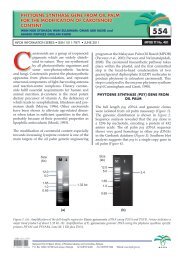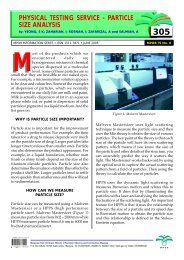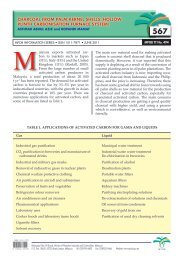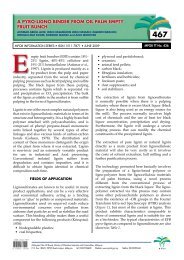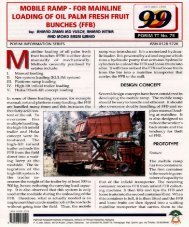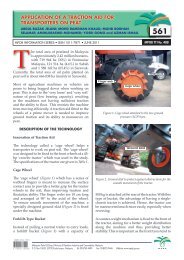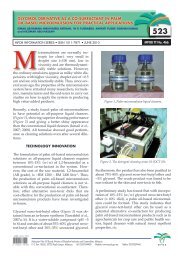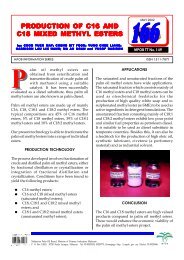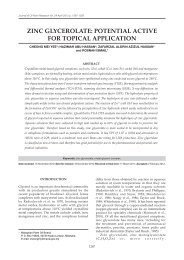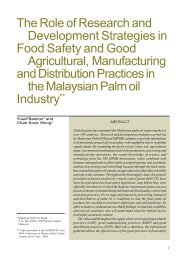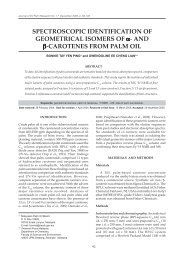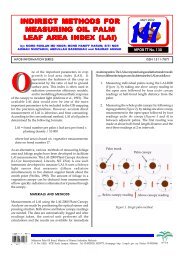ILLEGITIMACY IN OIL PALM BREEDING - A REVIEW - PALMOILIS
ILLEGITIMACY IN OIL PALM BREEDING - A REVIEW - PALMOILIS
ILLEGITIMACY IN OIL PALM BREEDING - A REVIEW - PALMOILIS
Create successful ePaper yourself
Turn your PDF publications into a flip-book with our unique Google optimized e-Paper software.
JOURNAL Journal of OF Oil <strong>OIL</strong> Palm <strong>PALM</strong> Research RESEARCH Vol. 17 (JUNE 17 June 2005) 2005, p. 64-69<br />
<strong>ILLEGITIMACY</strong> <strong>IN</strong> <strong>OIL</strong> <strong>PALM</strong> BREED<strong>IN</strong>G - A<br />
<strong>REVIEW</strong><br />
* Highlands, New Road,<br />
Great Barford, Bedford MK44 3LQ,<br />
United Kingdom.<br />
E-mail: herewardc@aol.com<br />
CORLEY, R H V *<br />
ABSTRACT<br />
Shell thickness and molecular marker data indicate that illegitimacy and contamination are more widespread<br />
in oil palm breeding programmes than is usually acknowledged. Before the discovery of the mode of inheritance<br />
of shell thickness, no markers were available to detect illegitimacy. Once shell thickness could be used as a<br />
marker, it became clear that control of pollination needed improvement. However, in present day programmes<br />
anomalous segregation ratios and contamination with the wrong fruit forms still occur from time to time, and<br />
work with molecular markers shows that illegitimacy may occur even when fruit form segregation is correct.<br />
Where there is illegitimacy, family selection will be unreliable, and inadvertent inbreeding may take place.<br />
Now that molecular markers are widely available, it should be standard practice in oil palm breeding to test<br />
all crosses for legitimacy. The requirements for this are discussed.<br />
Keywords: contamination, fruit forms, molecular markers, segregation, shell thickness.<br />
Date received: 9 July 2004; Sent for revision: 3 August 2004; Received in final form: 9 March 2005; Accepted: 14 March 2005.<br />
<strong>IN</strong>TRODUCTION<br />
In any breeding programme, it is important to know<br />
the parentage of families and individuals, for a<br />
variety of reasons. Oil palm breeders make extensive<br />
use of family performance, usually selecting the best<br />
individual plants within the best families. Such<br />
selection will only be effective if families are correctly<br />
identified, and are truly families; that is, all<br />
individuals have the same parentage. Progeny<br />
testing is also used, individual parent palms being<br />
evaluated on the basis of the performance of their<br />
offspring. This will not be valid if some of the<br />
offspring are illegitimate. A notable feature of oil<br />
palm breeding programmes is the very narrow<br />
genetic base of some of the ancestral populations.<br />
The palm is naturally cross-pollinating, and<br />
inbreeding causes yield depression (Hardon, 1970;<br />
Luyindula et al., in press). To ensure that the parents<br />
used for commercial hybrid seed production are not<br />
related, oil palm breeders rely on pedigrees (e.g.,<br />
Rosenquist, 1986). For a pedigree to be useful, it is<br />
essential that the crosses were made correctly.<br />
64<br />
Controlled pollination of oil palms is difficult, and<br />
prone to various sources of error; detailed<br />
descriptions of methods and the necessary checks<br />
and quality control procedures have been published<br />
(Donough et al., 1993; Chin, 1999; Rao and Kushairi,<br />
1999), but it is not clear to what extent good control<br />
was practised in the past. Possible problems include<br />
damage to bags by rats, squirrels, oil palm spines or<br />
simply from repeated use; pollen-bearing weevils<br />
will enter damaged bags, causing contamination by<br />
illegitimate pollen. In some female inflorescences,<br />
the accompanying male flowers may produce viable<br />
pollen (Beiranert, 1935), so that some self-pollination<br />
could occur. Because of the obvious risk of errors,<br />
pollination is usually subject to careful supervision,<br />
but errors may also occur in pollen collection or<br />
storage, in labelling bunches on the palm, in the seed<br />
store or the nursery, and during field planting of<br />
trials. In this paper, I will show that illegitimacy and<br />
contamination (some illegitimate palms in a family)<br />
may have been more widespread in oil palm<br />
breeding programmes than is usually acknowledged.<br />
SHELL THICKNESS AND <strong>ILLEGITIMACY</strong><br />
Shell thickness is an important yield component,<br />
whose inheritance was elucidated by Beirnaert and<br />
Vanderweyen (1941). Control is by a single gene,
and the fruit form of palms within families may<br />
reveal the existence of illegitimate or contaminated<br />
crosses in two ways. The occurrence of unexpected<br />
fruit forms is a certain indication of problems;<br />
examples include thin-shelled teneras (T) in a thickshelled<br />
dura x dura (DxD) family, Ds in a thin-shelled<br />
dura x pisifera (P) cross, or shell-less Ps in a TxD cross.<br />
In some cases, the unexpected fruit forms may not<br />
be the only contaminants; for example, if Ts in a DxD<br />
cross result from contamination with tenera pollen,<br />
some of the duras in the family will also be<br />
illegitimate.<br />
The second way in which fruit form can indicate<br />
contamination is by segregation ratios which differ<br />
statistically from Mendelian expectations. This is less<br />
useful, because low levels of contamination will not<br />
significantly alter the segregation ratio, unless very<br />
large numbers of palms are involved. For example,<br />
in a TxT cross with 80 palms, a typical number per<br />
family in an oil palm breeding programme, 30%<br />
contamination with dura pollen would give the<br />
following numbers:<br />
Legitimate T pollen: 14 D 28 T 14 P<br />
Illegitimate D pollen: 12D 12T -<br />
Total: 26D 40T 14P<br />
These numbers, compared to an expected<br />
20:40:20, give a Chi 2 value of 3.6 (probability of a<br />
larger value = 5.8%). Thus, more than 30%<br />
contamination must occur before the segregation<br />
ratio will differ significantly from the expected 1:2:1<br />
D:T:P.<br />
It is worth noting that identification of the fruit<br />
forms can sometimes be difficult. Very thin-shelled<br />
Ds may be classed as T; it is essential to look for the<br />
diagnostic mesocarp fibres in a T, seen as a ring<br />
surrounding the nut in transverse fruit sections.<br />
Another possible source of error is the existence of<br />
fertile Ps which actually have small amounts of<br />
lignified tissue adjacent to the kernel. This tissue<br />
does not completely surround the kernel to form a<br />
shell, but is discernible in fruit cross-sections.<br />
Beirnaert and Vanderweyen’s work was<br />
published over 60 years ago, but many annual<br />
reports and other publications still make no mention<br />
of fruit form segregation. As shown by the examples<br />
discussed below, it is clear that many oil palm<br />
breeding programmes have included illegitimate or<br />
contaminated crosses. However, it is not always<br />
clear to what extent this has been recognized.<br />
Palm SP540<br />
Serious breeding work started in Sumatra soon<br />
after First World War. One of the most important<br />
palms was the tenera SP540 at Sungei Pantjur, which<br />
was part of a consignment of seed sent by the<br />
65<br />
<strong>ILLEGITIMACY</strong> <strong>IN</strong> <strong>OIL</strong> <strong>PALM</strong> BREED<strong>IN</strong>G - A <strong>REVIEW</strong><br />
Director of the Eala Botanic Gardens in the Congo.<br />
The seed was recorded as var. Djongo, indicating that<br />
it came from the Djongo tenera palm from the<br />
Yangambi programme (Rosenquist, 1986). A total<br />
of only 13 seedlings survived: of these, eight were<br />
Ds and five Ts, so the Djongo seed was presumably<br />
an open-pollinated TxD or TxT cross. Figure 1 shows<br />
that SP540 was one of the ancestors of the AVROS<br />
pisiferas now widely used for seed production in<br />
Indonesia, Malaysia, Papua New Guinea and Costa<br />
Rica (Rajanaidu and Jalani, 1999). The pedigree, as<br />
usually published, shows family Pol 820 as a selfing<br />
of SP540. However, the family had only two Ps<br />
among 123 palms (Hartley, 1977), whereas about 30<br />
would be expected from a T selfing. Hartley did not<br />
mention the number of Ds and Ts in the family, but<br />
a Chi 2 test shows that deviation from the expected<br />
segregation of 1:3 P:D+T is highly significant. Thus,<br />
the family Pol 820 was probably predominantly an<br />
illegitimate TxD out-cross (though some T pollen<br />
must have been present to give the two Ps in the<br />
family). At that time, the inheritance of shell<br />
thickness was not understood, so this illegitimacy<br />
was apparently not recognized. Recent work with<br />
molecular markers supports this, in that there was a<br />
greater degree of heterozygosity in AVROS family<br />
DM742 (Figure 1) than expected from the pedigree<br />
(Mayes, 1995).<br />
AVROS material is sometimes referred to as being<br />
75% Djongo, but if SP540 was from open-pollinated<br />
seed and Pol 820 was illegitimate, there might be less<br />
than 20% of genes from the Djongo palm in presentday<br />
AVROS material.<br />
Early Work with Teneras and Pisiferas in<br />
Malaysia<br />
Before the Second World War, selection work had<br />
started in the Deli dura population in Malaya.<br />
Publication of the Congo Theory of inheritance of shell<br />
thickness excited interest in Ts and Ps. Pollen was<br />
imported from Africa, and DxT and DxP crosses were<br />
made. Segregation of fruit forms in crosses made in<br />
the 1950s was often incorrect: of 24 DxT crosses in<br />
one programme, seven had segregation ratios which<br />
differed significantly from the expected 1:1 D:T,<br />
based on a Chi 2 test (Rosenquist, per. comm., 1994).<br />
In all but one of these, there was an excess of Ds.<br />
Among nearly 3000 palms from DxP crosses in the<br />
same programme, 22% were Ds.<br />
Some of the first commercial DxP plantings were<br />
made by Oil Palms of Malaya (OPM) in 1958. A<br />
random sample of 20 palms from the 1958 OPM<br />
planting included 13 Ds (Corley, unpublished); this<br />
is a small sample, but for a binomial distribution,<br />
the 95% confidence limits for the population as a<br />
whole are between 41% and 85% D (Snedecor and<br />
Cochran, 1966). A similar 20-palm sample from a
JOURNAL OF <strong>OIL</strong> <strong>PALM</strong> RESEARCH 17 (JUNE 2005)<br />
Note: Palm numbers in italics; other numbers are progeny codes.<br />
Source: Modified from Corley and Tinker (2003).<br />
1960 planting included 17 Ds; the confidence limits<br />
for that population are between 62% and 97% D.<br />
These plantings had a very high degree of<br />
illegitimacy, therefore. The most likely source of<br />
contamination with D pollen would have been from<br />
other Ds surrounding the female parents.<br />
Cameroons Breeding Programme<br />
In trials planted in the Cameroons in the mid<br />
1960s, fruit form segregations showed numerous<br />
errors (Langham, R M, unpublished). Of 132 crosses<br />
planted in 1966 and 1967, 42 showed either<br />
significant deviations from the expected segregation<br />
ratios or contamination with incorrect fruit forms.<br />
Reasons for the errors were not always clear, but 17<br />
DxD crosses were contaminated, with an average of<br />
8% Ts. These crosses would have been made in<br />
blocks containing many Ts, so contamination with<br />
pollen from surrounding palms could result in Ts in<br />
a DxD cross. However, two DxD crosses included a<br />
P, which could not have arisen by contamination of<br />
a D mother palm in the field; mixing of seed, or of<br />
nursery plants, is the most likely explanation here.<br />
Two supposed DxP crosses segregated 50:50 D:T, so<br />
were probably erroneously made with T pollen<br />
instead of P.<br />
Figure 1. Ancestry of AVROS material.<br />
66<br />
Binga Breeding Programme, Congo<br />
Dumortier et al. (1992) described a large<br />
programme in the Congo consisting of over 30 trials<br />
planted during the 1970s; their report shows that<br />
both contamination and incorrect segregation ratios<br />
were common. Among 88 DxD, TxD and TxP<br />
crosses, 52% of crosses were contaminated with<br />
wrong fruit forms, with an overall contamination<br />
rate of 3%. Ignoring contamination with wrong fruit<br />
forms, 21% of 452 TxT, TxP, TxD and DxT crosses<br />
had fruit form segregation ratios which were<br />
significantly different from expectations.<br />
These figures suggest that control of pollination<br />
might have been poor, but in 147 DxP crosses planted<br />
at the same time, there was only 0.7% D<br />
contamination. Closer examination reveals a<br />
discrepancy: 4 DxP crosses included in trials with<br />
other types of crosses had 13% Ds, whereas the<br />
remaining 143 crosses, in trials which included only<br />
DxP crosses, had 0.3% Ds. This indicates that the<br />
main problem was probably not contamination<br />
during pollination, but mixing up of families either<br />
in the nursery or during field planting. If families<br />
were mixed in a DxP trial, that would not be<br />
detectable in the fruit forms, whereas in a trial with<br />
different types of crosses, mixing could lead to both<br />
detectable contamination, and incorrect segregation<br />
ratios.
A further problem in this programme is an excess<br />
of Ts. Averaged over all TxT crosses, in four trials<br />
with between 1500 and 2500 palms each, the<br />
proportion of Ts ranged from 54% to 58%. Based on<br />
the totals in each trial, the deviation from expectation<br />
(Chi 2 test) was highly significant. The most likely<br />
explanation of this anomaly seems to be incorrect<br />
fruit typing, but the possibility of a genetic effect,<br />
such as a lethal recessive gene closely linked to the<br />
shell-thickness gene, cannot be ruled out.<br />
MOLECULAR MARKERS AND<br />
<strong>ILLEGITIMACY</strong><br />
A low level of contamination of a TxT cross, or by T<br />
pollen in a DxT cross, is not detectable by fruit form.<br />
Similarly, mixing of families would not be detectable<br />
in DxD or DxP trials. Now, though, the development<br />
of molecular markers has allowed illegitimate<br />
crosses to be identified even when the shell thickness<br />
gene is not segregating. The legitimacy of individual<br />
palms can also be tested.<br />
Family Bg143<br />
This family, planted in 1973 at Binga, Democratic<br />
Republic of Congo, has been extensively used in<br />
some recent breeding programmes (Rosenquist et al.,<br />
1990). The family was supposed to be a self of T<br />
palm 312/3; the fruit forms segregated in the ratio<br />
26:44:30 D:T:P, which is not significantly different<br />
from the expected 1:2:1. Yield of the family was<br />
much better than expected for a selfing, and<br />
Rosenquist et al. (1990) observed that palm 312/3<br />
appeared to be tolerant of inbreeding. However, when<br />
molecular marker techniques were developed, it<br />
became clear that Bg143 was not a legitimate cross:<br />
of 12 palms examined, eight had marker bands not<br />
shown by 312/3, so could not have come from self<br />
pollination of that palm (Mayes, per. comm., 1993).<br />
This, rather than tolerance of inbreeding, probably<br />
explains the unexpectedly high yield of the family.<br />
Illegitimacy in a DxP Trial<br />
In one DxP trial, planted in the 1990s, D<br />
contamination was negligible. However, molecular<br />
marker analysis showed that six crosses out of 58<br />
tested carried bands which were not present in either<br />
parent, and so were contaminated or illegitimate. As<br />
noted above, contamination in the field in a Deli dura<br />
seed garden is most likely to be with D pollen. An<br />
illegitimate DxP family which does not contain Ds<br />
must have arisen from use of pollen from the wrong<br />
pisifera, or from mislabelling of seed or seedlings at<br />
some stage.<br />
67<br />
<strong>ILLEGITIMACY</strong> <strong>IN</strong> <strong>OIL</strong> <strong>PALM</strong> BREED<strong>IN</strong>G - A <strong>REVIEW</strong><br />
DISCUSSION<br />
Before the Second World War, most of the breeding<br />
work in Southeast Asia was with Deli dura. In the<br />
absence of a good marker gene, there was no way of<br />
knowing whether control of pollination was<br />
adequate. Even where Ts or Ps were used, the<br />
inheritance of shell thickness was not understood,<br />
and illegitimacy appears not to have been<br />
recognized, as in the descendants of SP540. It was<br />
only after the work of Beirnaert and Vanderweyen<br />
(1941) that it became feasible to monitor the efficacy<br />
of controlled pollination. In this respect, the early<br />
commercial plantings of DxP material in Malaysia<br />
are of interest. As noted above, the first plantings<br />
had a very high level of dura contamination. The<br />
1958 planting would have started fruiting in 1961,<br />
at which point the contamination would have been<br />
recognized. It is clear that immediate and effective<br />
steps were taken to improve the control of<br />
pollination: a 20-palm sample from a 1963 OPM<br />
planting was 100% T. An important implication of<br />
this is that contamination may have been very<br />
extensive in earlier Deli dura breeding programmes,<br />
but was not detected because all palms were D.<br />
Most oil palm breeders and seed producers agree<br />
that, with good control of pollination, D<br />
contamination in DxP crosses should be below 1%.<br />
From 1963 until the introduction of Elaeidobius<br />
kamerunicus in 1982 contamination in Malaysian<br />
commercial plantings was generally low. It appears<br />
that Thrips hawaiiensis, the main pollinating agent at<br />
that time, rarely gained access to bagged female<br />
inflorescences. However, E. kamerunicus is much<br />
more persistent, and after it was introduced D<br />
contamination became a significant problem. Rao<br />
et al. (1994) quoted average figures of 10%-20% for<br />
two plantation companies, while Donough and Law<br />
(1995) found up to 45% Ds in individual plantings.<br />
This problem appears to have persisted for much of<br />
the 1980s, but in a 1991 comparison of seed sources,<br />
contamination had been reduced to below 2% (Rao<br />
and Kushairi, 1999), indicating that control had been<br />
restored.<br />
In view of the problems which arose after the<br />
introduction of the weevil to Malaysia, it is worth<br />
considering how effective control of pollination<br />
might have been in the early days of oil palm<br />
breeding in Africa, where several species of<br />
Elaeidobius were always present. In his programme<br />
in the Congo, Beirnaert found some crosses among<br />
his TxT crosses and T-selfs which diverged<br />
significantly from the expected 1:2:1 ratio. The<br />
proportion of teneras remained constant at about<br />
50%, but a few palms gave as much as 35% or as<br />
little as 15% Ds, with a correspondingly low or high<br />
proportion of Ps (Beirnaert and Vanderweyen, 1941).<br />
Beirnaert does not seem to have considered the<br />
possibility of contamination, but at first sight this
JOURNAL OF <strong>OIL</strong> <strong>PALM</strong> RESEARCH 17 (JUNE 2005)<br />
could explain his results. Contamination of a TxT<br />
cross with dura pollen would give an excess of Ds,<br />
without affecting the proportionof Ts, because both<br />
TxT and TxD crosses have 50% Ts. Similarly,<br />
contamination with pisifera pollen would give an<br />
excess of Ps without affecting the proportion of Ts.<br />
However, Beirnaert’s results were very consistent,<br />
with a palm giving the same divergence from<br />
expectation whether it was the male or the female<br />
parent in a cross; this is not easily explained in terms<br />
of contamination.<br />
Beirnaert did not mention the fibre ring which is<br />
characteristic of Ts, and is now regarded as<br />
diagnostic. He apparently classified fruit forms<br />
simply on the basis of shell thickness. Thus, a<br />
possible source of error in his data would be<br />
confusion between thick-shelled Ts and thin-shelled<br />
Ds. Where he found an excess of Ds, it was at the<br />
expense of Ps, not of Ts, but most of his data appear<br />
to be combined results for several families with the<br />
same parent, rather than data for single families,<br />
which could lead to further confusion. We cannot<br />
be certain that control of pollination was good in<br />
Beirnaert’s time, therefore, but we do know that it<br />
was good enough to allow him to deduce how shell<br />
thickness is inherited.<br />
Elsewhere in Africa, there were clearly problems.<br />
In Nigeria in 1954, it was stated that in many instances,<br />
segregations ... are not at all in line with the theories<br />
(WAIFOR Second Annual Report, 1953-54). No details<br />
were given, but it was noted that most of the affected<br />
crosses were made at places or times when<br />
supervision was poor. “Mixing of families in<br />
nurseries is inversely proportional to the motivation<br />
of the staff in charge, or to the distance between office<br />
and field” (Durand-Gasselin, per. comm., 2004). In<br />
1958, Dr A G Prendergast visited Congo (per. comm.,<br />
2000); he considered that control of pollination at<br />
Yangambi was good, with female inflorescences<br />
isolated in double bags, but elsewhere he saw single<br />
bags with holes being used.<br />
It appears, therefore, that contamination might<br />
have been a significant problem in the early days of<br />
many programmes, at least until the inheritance of<br />
shell thickness was understood and it could be used<br />
as a marker gene. Thereafter, control did improve,<br />
but we have seen that contamination and incorrect<br />
segregation were still common in programmes in the<br />
Cameroons and Congo in the 1960s and 1970s, and<br />
illegitimacy has been identified in a 1990s<br />
programme using molecular markers.<br />
CONCLUSION<br />
It is clear from this survey that contamination and<br />
illegitimacy have been significant throughout the<br />
history of oil palm breeding. Until now, this has<br />
perhaps not mattered too much: steady breeding<br />
68<br />
progress has been made, with yields being doubled<br />
between 1950 and 1990 (Corley and Lee, 1992).<br />
Provided that yield records are accurate, mass<br />
selection of the best individuals should ensure<br />
progress, whether or not those individuals are<br />
legitimate. However, future breeding progress will<br />
rely increasingly on family selection and progeny<br />
testing, which require a high degree of legitimacy;<br />
reliable pedigrees are also necessary to avoid<br />
inbreeding.<br />
Now that molecular markers are available, I<br />
suggest that it should become standard practice in<br />
all oil palm breeding programmes to check the<br />
legitimacy of crosses using markers. It is necessary<br />
to find markers which are polymorphic (showing<br />
different bands) between legitimate and illegitimate<br />
parents. There are several possible causes of<br />
illegitimacy, as listed below:<br />
• use of pollen from the wrong palm. Here,<br />
markers polymorphic among all palms from<br />
which pollen is being collected are needed.<br />
• contamination during the pollination<br />
operation, by pollen from surrounding<br />
palms. Here, markers which are<br />
polymorphic within the female parental<br />
population are needed; these may be quite<br />
difficult to find in homogeneous material<br />
such as some Deli dura populations,<br />
particularly if the surrounding palms are sibs<br />
of the parent palm.<br />
• accidental self pollination by accompanying<br />
male flowers. This is probably undetectable<br />
with molecular markers, but will cause D<br />
contamination in a DxP cross.<br />
• incorrect labelling of seeds or seedlings.<br />
Markers for both female and male parental<br />
populations will be needed here. At some<br />
stations, seed production and breeding<br />
operations are kept physically separate, with<br />
little or no risk of mixing between them. This<br />
may simplify the choice of markers.<br />
Once polymorphic markers have been found,<br />
bulked DNA from several palms in a family can be<br />
used for testing, so the amount of work need not be<br />
onerous. Illegitimacy can be proved by the presence<br />
of marker alleles not found in either putative parent,<br />
but legitimacy is a matter of probability, and cannot<br />
be proved. The more markers tested, the greater the<br />
confidence one can have. Assuming two alleles for<br />
each marker, confidence would be 2 n , where n is the<br />
number of markers. Thus, if five markers all give<br />
results consistent with legitimacy, the chance of the<br />
family being illegitimate would be only one in 32,<br />
or about 3%, which would probably be good enough<br />
for most purposes. With microsatellites one can<br />
usually identify more than two alleles per marker,
so the number of markers needed might be fewer<br />
than five.<br />
Lim and Rao (2004) describe the facilities<br />
required, and estimate the costs of setting up and<br />
running a marker laboratory. There are marker<br />
methods available now which are simple and cheap<br />
to apply, and a marker laboratory should form an<br />
adjunct to every serious oil palm breeding<br />
programme. In the longer term, the greatest benefits<br />
will come from the development of marker-assisted<br />
selection, but detection of contaminated and<br />
illegitimate crosses is also very important, and<br />
significant cost savings could be made by eliminating<br />
such crosses before field planting (Lim and Rao,<br />
2004).<br />
ACKNOWLEDGEMENT<br />
I am grateful to several plant breeders for<br />
information, and to P L Jack for discussion of marker<br />
methods.<br />
REFERENCES<br />
BEIRNAERT, A (1935). Introduction à la biologie<br />
florale du palmier à huile (Elaeis guineensis Jacquin).<br />
Publ. Inst. Nat. Etude agron. Congo Belge, Ser. Sci., 5: 3-<br />
42.<br />
BEIRNAERT, A and VANDERWEYEN, R (1941).<br />
Contribution a l’étude génétique et biométrique des<br />
variétés d’Elaeis guineensis Jacquin. Publ. Inst. Nat.<br />
Etude agron. Congo Belge, Ser. Sci. , 27: 1-101.<br />
CH<strong>IN</strong>, C W (1999). Oil palm breeding techniques.<br />
Proc. of the Science of Oil Palm Breeding Seminar<br />
(Rajanaidu, N and Jalani, B S eds.). PORIM, Bangi.<br />
p. 49-64.<br />
CORLEY, R H V and LEE, C H (1992). The<br />
physiological basis for genetic improvement of oil<br />
palm in Malaysia. Euphytica, 60: 179-184.<br />
CORLEY, R H V and T<strong>IN</strong>KER, P B (2003). The Oil<br />
Palm. Blackwell Science, Oxford.<br />
DONOUGH, C R; NG, M and LAI, C (1993). Pamol’s<br />
approach to quality control in controlled pollination<br />
for DxP seed production. The Planter, 69: 163-175.<br />
DONOUGH, C R and LAW, I H (1995). Breeding and<br />
selection for seed production at Pamol Plantations<br />
Sdn Bhd and early performance of Pamol DxP. The<br />
Planter, 71: 513-530.<br />
69<br />
<strong>ILLEGITIMACY</strong> <strong>IN</strong> <strong>OIL</strong> <strong>PALM</strong> BREED<strong>IN</strong>G - A <strong>REVIEW</strong><br />
DUMORTIER, F; VAN AMSTEL, H and CORLEY, R<br />
H V (1992). Oil Palm Breeding at Binga, Zaire, 1970 -<br />
1990. Unilever Plantations, London.<br />
HARDON, J J (1970). Inbreeding in populations of<br />
the oil palm (Elaeis guineensis Jacq.) and its effects on<br />
selection. Oléagineux, 25: 449-456.<br />
HARTLEY, C W S (1977). The Oil Palm. 2 nd edition.<br />
Longmans, London and New York. p. 201.<br />
LIM, C C and RAO, V (2004). DNA marker<br />
technology and private sector oil palm breeding. The<br />
Planter, 80: 611-628.<br />
LUY<strong>IN</strong>DULA, N; MANTANTU, N; DUMORTIER,<br />
F and CORLEY, R H V. Effects of inbreeding on<br />
growth and yield of oil palm. Euphytica. In press.<br />
MAYES, S (1995). The Application of Biotechnology<br />
toward the Genetic Improvement of Oil Palm. Thesis.<br />
Open University, United Kingdom.<br />
RAJANAIDU, N and JALANI, B S (1999). Worldwide<br />
production, performance and issues related to<br />
oil palm planting materials. Proc. of the 1996 Seminar<br />
on Sourcing of Oil Palm Planting Materials for Local and<br />
Overseas Joint Ventures (Rajanaidu, N and Jalani, B S<br />
eds.). PORIM, Bangi. p. 28-70.<br />
RAO, V; JALANI, B S and RAJANAIDU, N (1994).<br />
Effect of dura contamination on oil extraction rate<br />
(OER). Proc. of the National Seminar on Palm Oil<br />
Extraction Rate: Problems and Issues (Arrifin, D and<br />
Jalani, B S eds.). PORIM, Bangi. p. 58-60.<br />
RAO, V and KUSHAIRI, A (1999). Quality of oil palm<br />
planting material. Proc. of the 1996 Seminar on Sourcing<br />
of Oil Palm Planting Materials for Local and Overseas<br />
Joint Ventures (Rajanaidu, N and Jalani, B S eds.).<br />
PORIM, Bangi. p. 188-197.<br />
ROSENQUIST, E A (1986). The genetic base of oil<br />
palm breeding populations. Proc. of the International<br />
Workshop on Oil Palm Germplasm and Utilisation.<br />
PORIM, Bangi. p. 27-56.<br />
ROSENQUIST, E A; CORLEY, R H V and DE GREEF,<br />
W (1990). Improvement of tenera populations using<br />
germplasm from breeding programmes in<br />
Cameroon and Zaire. Proc. of the Workshop on Progress<br />
of Oil Palm Breeding Populations. PORIM, Bangi. p.<br />
37-69.<br />
SNEDECOR, G W and COCHRAN, W G (1966).<br />
Statistical Methods. Fifth edition. Iowa State<br />
University Press, Ames, Iowa.


